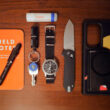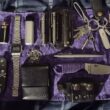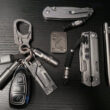When choosing the best pocket knife for your everyday carry, one of the decisions you’ll need to make is what type of blade edge you should choose.
The common recommendation is to go with a plain edge (for reasons we’ll get into later), but you might notice two other types of edges: serrated and combo edges. Instead of an unbroken edge on the blade, these two alternatives add some “teeth” to the knife.
You may not have needed serrations on your knife before, or don’t know enough about them to add them to your kit. In our last guide for custom-designed knives for everyday carry, one reader asked: “Why don’t you guys ever feature serrated knives?”
Well today we will, and our goal is to compare each type of edge in the context of EDC tasks so you can make the right choice when picking one.
Plain Edge Knives
10 EDC knives with plain edge blades, all under $50. Click to see the full guide.
First let’s talk about the most common knife type—plain edge knives. They have a continuous edge that make them the most versatile, with many different blade shapes to best make the use of a straight edge.
Since your main cutting action is to apply steady pressure to perform cuts, a long, unbroken edge lets you perform general cutting tasks cleanly and with minimal resistance.
Plain edges are also much easier to maintain since the unbroken edge is easier to sharpen or reprofile. A solid, plain edge knife with a general-purpose shape is sure to serve you many years over with maintenance you can perform yourself.
Pros:
- Versatile and useful for most tasks
- Easy to sharpen
- Cleaner cuts through most materials
Cons:
- Tougher materials will give a plain edge more trouble
Plain edge knives we recommend: Ontario RAT II, Kershaw Skyline, Spyderco Roadie
Serrated Edge Knives
 Specialized serrations on the Leatherman Skeletool RX help first responders and EMTs cut tough fabrics like clothing and seatbelt webbing.
Specialized serrations on the Leatherman Skeletool RX help first responders and EMTs cut tough fabrics like clothing and seatbelt webbing.
So what exactly are serrations? They’re the teeth-like edge ground into a knife’s blade, creating a long series of small edges. If you’ve ever handled a saw or bread knife, then you’ve probably seen them before.
These mini edges make it easier to cut into hardier or uneven materials where you can’t apply steady pressure and have to resort to different angles of approach to cut through. Think rope, tree branches, or even a thick piece of bread—with a plain edge it would take you forever to cut through, but a serrated edge’s teeth keeps your cutting momentum going once the teeth “bite” into the material.
The big drawback to serrated edges is maintenance. Lots of small edges means lots of work to sharpen all of them when they eventually start to dull down. Even though a serrated blade stays useful for longer than a plain edge knife, when it does get dull you’re looking at either specialty sharpeners or a professional to get it back to factory sharpness. This makes a serrated knife a more specific-purpose type of knife compared to a general-purpose plain edge one.
Pros:
- Makes short work of tougher materials
- Keeps its edge(s) and bite for longer than a plain edge
Cons:
- Does not make a clean cut because of its teeth
- Harder to maintain
- Useful in fewer situations overall
Serrated edge knives we recommend: Spyderco Native 5, Cold Steel Tuff Lite Serrated, Victorinox One-Handed Trekker
Combo Edge Knives
Combo edge as seen on the Benchmade Mini Griptilian.
Sometimes you just can’t choose which edge you’ll need for the day’s tasks, or you don’t want to carry two different knives with you. This is where a combo edge comes in handy, because as its name suggests, it brings both types of serration onto one edge. While this gives you the best of both worlds of utility, it also gives you twice the work of maintaining both edges on your knife.
A combo knife gives you both a plain edge and serrations, but you get less cutting length to work with on each. For the more common combo edge knives, most of the edge is a plain edge, giving you the ability to still make long and clean cuts. The plain edge is often closer to the tip than the handles to give you better leverage and precision. The serrated portion is usually nearer to the handles and your hand, giving you a better grip to push and pull when putting the serrations to use on tougher cuts.
Pros:
- The best of both worlds of utility
- Saves you from having to carry two knives
- Many popular everyday carry knives come in a combo edge version
Cons:
- You lose length for both types of edges, which may hamper cutting action
Combo edge knives we recommend: Benchmade Mini Griptilian, Kershaw Link Serrated, Spyderco Tenacious
Which edge is best for most people?
For general everyday tasks, a plain edge is your best bet. It gives you a clean cut with a long edge for constant pressure and precision.
A serrated edge becomes useful when dealing with tough materials, like cutting through rope, heavy fabrics, or foliage. A serrated knife would be right at home in a toolbox or camping bag where its functionality is most needed. Plus, since it holds an edge for longer, you don’t have to worry about maintaining it for a long time, and after a lot of hard use.
If you don’t want to commit to either edge and want to cover all your bases, then a combo edge would be best for you. In exchange for a slightly shorter cutting length you get to have both precision and bite in a single knife. Even better, many popular knives come in a combo edge, so you don’t have to sacrifice your needs from a certain brand or model.
What kind of edge does your everyday carry knife have? Let us know which type of knife you chose and why in the comments below.











